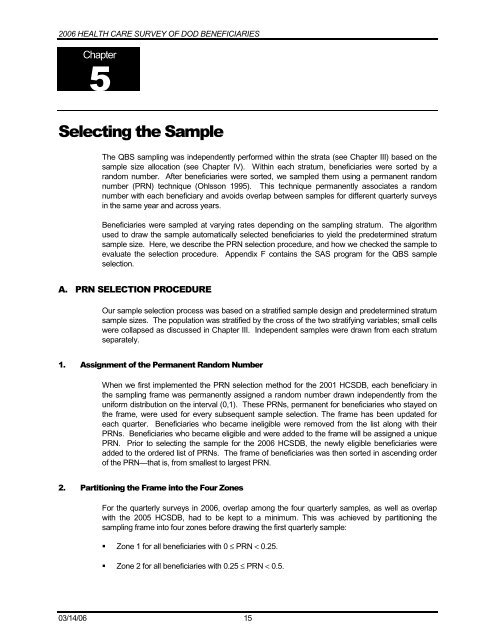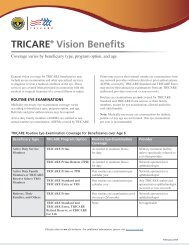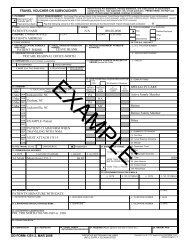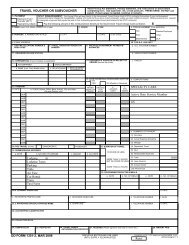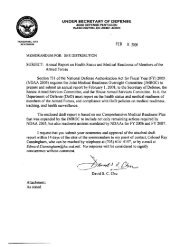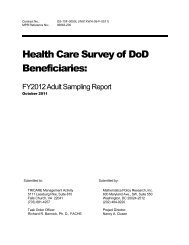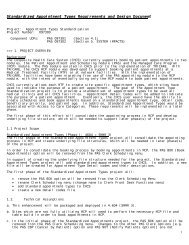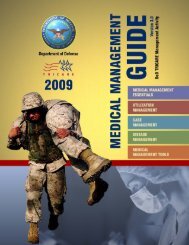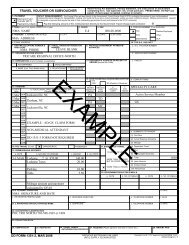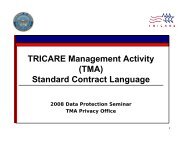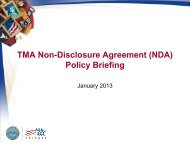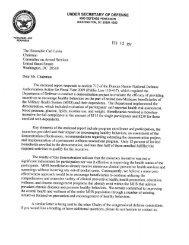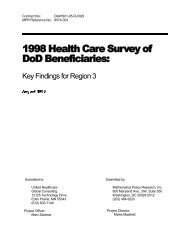2006 HCSDB Adult Sampling Report - Tricare
2006 HCSDB Adult Sampling Report - Tricare
2006 HCSDB Adult Sampling Report - Tricare
- No tags were found...
You also want an ePaper? Increase the reach of your titles
YUMPU automatically turns print PDFs into web optimized ePapers that Google loves.
<strong>2006</strong> HEALTH CARE SURVEY OF DOD BENEFICIARIESChapter6HOHFWLQJWKH6DPSOHThe QBS sampling was independently performed within the strata (see Chapter III) based on thesample size allocation (see Chapter IV). Within each stratum, beneficiaries were sorted by arandom number. After beneficiaries were sorted, we sampled them using a permanent randomnumber (PRN) technique (Ohlsson 1995). This technique permanently associates a randomnumber with each beneficiary and avoids overlap between samples for different quarterly surveysin the same year and across years.Beneficiaries were sampled at varying rates depending on the sampling stratum. The algorithmused to draw the sample automatically selected beneficiaries to yield the predetermined stratumsample size. Here, we describe the PRN selection procedure, and how we checked the sample toevaluate the selection procedure. Appendix F contains the SAS program for the QBS sampleselection.$ 3516(/(&7,21352&('85(Our sample selection process was based on a stratified sample design and predetermined stratumsample sizes. The population was stratified by the cross of the two stratifying variables; small cellswere collapsed as discussed in Chapter III. Independent samples were drawn from each stratumseparately.$VVLJQPHQWRIWKH3HUPDQHQW5DQGRP1XPEHUWhen we first implemented the PRN selection method for the 2001 <strong>HCSDB</strong>, each beneficiary inthe sampling frame was permanently assigned a random number drawn independently from theuniform distribution on the interval (0,1). These PRNs, permanent for beneficiaries who stayed onthe frame, were used for every subsequent sample selection. The frame has been updated foreach quarter. Beneficiaries who became ineligible were removed from the list along with theirPRNs. Beneficiaries who became eligible and were added to the frame will be assigned a uniquePRN. Prior to selecting the sample for the <strong>2006</strong> <strong>HCSDB</strong>, the newly eligible beneficiaries wereadded to the ordered list of PRNs. The frame of beneficiaries was then sorted in ascending orderof the PRN—that is, from smallest to largest PRN.3DUWLWLRQLQJWKH)UDPHLQWRWKH)RXU=RQHVFor the quarterly surveys in <strong>2006</strong>, overlap among the four quarterly samples, as well as overlapwith the 2005 <strong>HCSDB</strong>, had to be kept to a minimum. This was achieved by partitioning thesampling frame into four zones before drawing the first quarterly sample:ƒ Zone 1 for all beneficiaries with 0 ≤ PRN < 0.25.ƒ Zone 2 for all beneficiaries with 0.25 ≤ PRN < 0.5.03/14/06 15


